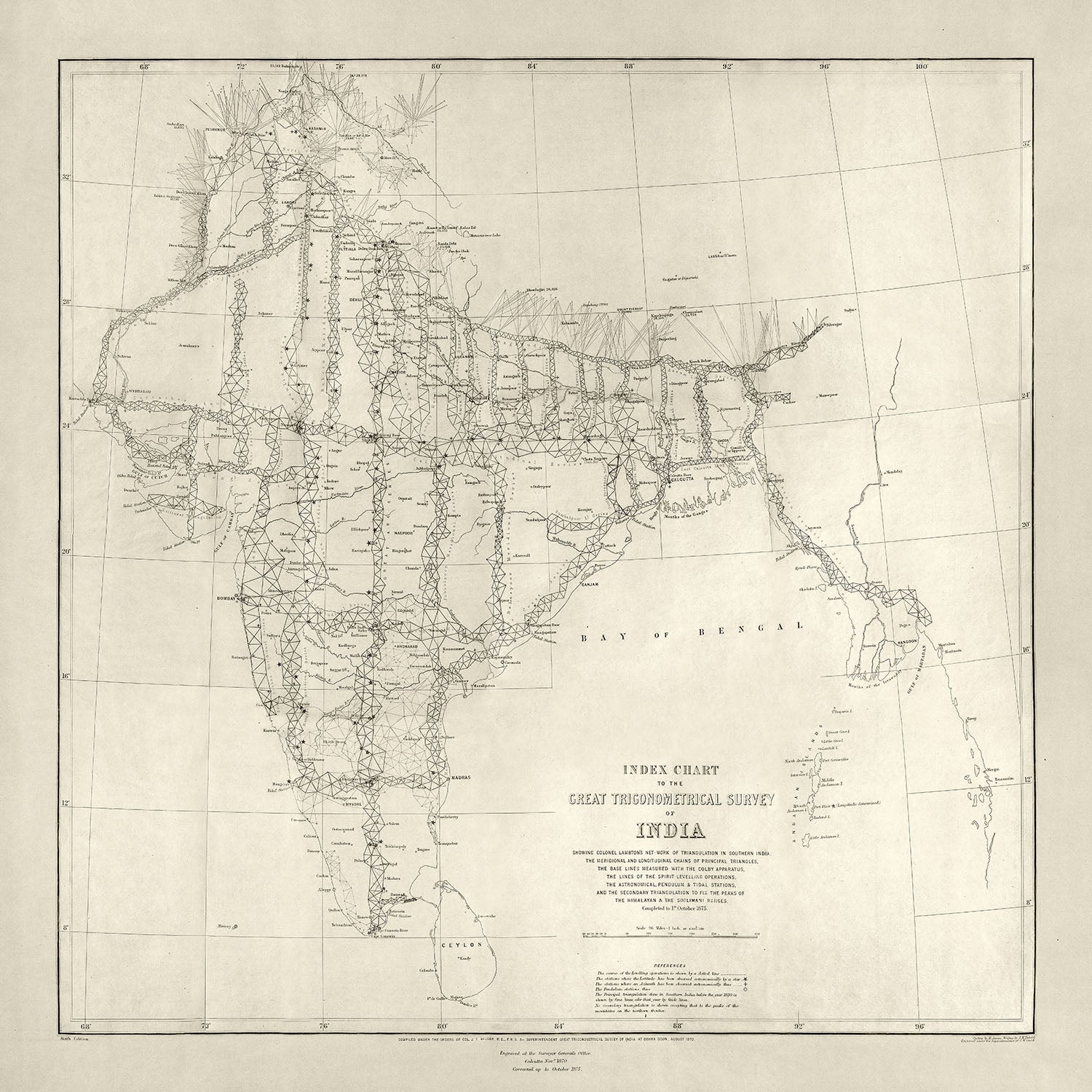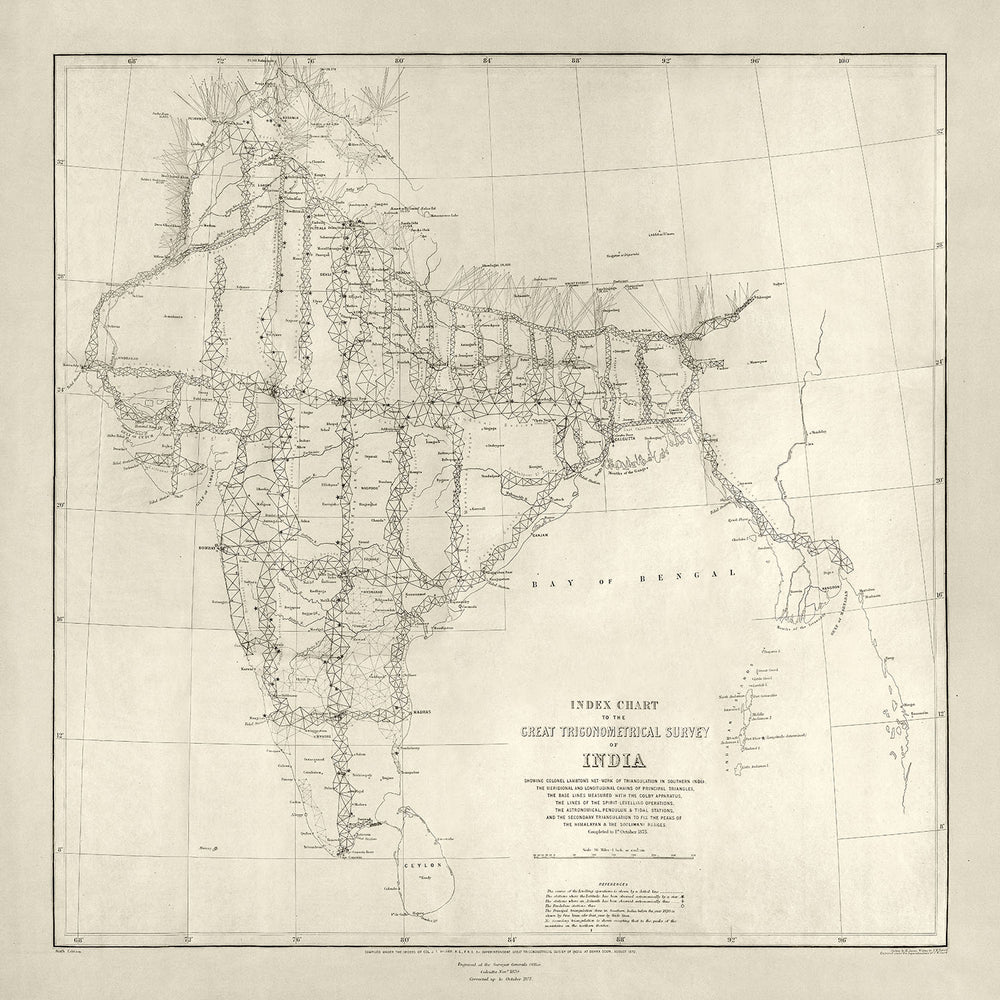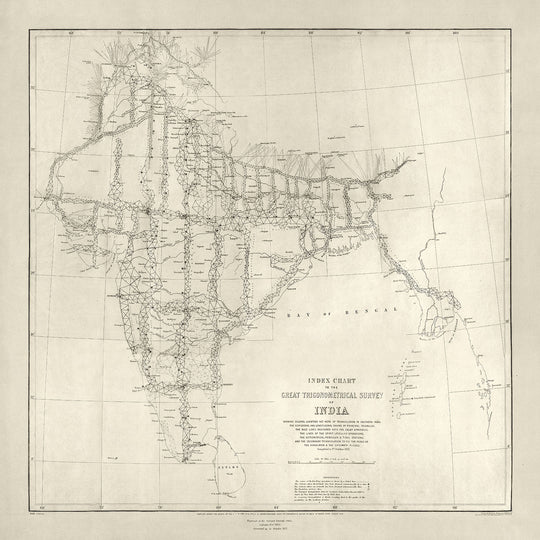- Handmade locally. No import duty or tax
- FREE worldwide delivery
- Love it or your money back (90 days)
- Questions? WhatsApp me any time
Own a piece of history
5,000+ 5 star reviews


The "Index Chart of the Great Trigonometrical Survey of India" is a captivating historical artifact that captures the essence of one of the most ambitious scientific endeavors of the 19th century. Created in 1875 by the Office of the Trigonometrical Survey of India, this map meticulously details the extensive network of trigonometrical stations established across the Indian sub-continent. The Great Trigonometrical Survey, initiated by the East India Company, was a monumental project aimed at mapping the vast and diverse landscapes of India with unparalleled precision. This map stands as a testament to the scientific rigor and dedication of the surveyors who undertook this colossal task over seven decades.
The mapmaker, the Office of the Trigonometrical Survey of India, played a pivotal role in advancing the field of cartography and geodesy. Their work not only involved recording topographical information and land ownership but also included measuring the depths of navigable waters and calculating the heights of the majestic Himalayan summits. The survey's scientific contributions were profound, leading to significant advancements in understanding the Earth's curvature and the heights of some of the world's tallest peaks. This map, therefore, is not just a geographical representation but also a symbol of scientific progress and exploration.
As you explore the map, you'll find a detailed depiction of the Indian sub-continent, including modern-day India, Pakistan, Bangladesh, and parts of surrounding regions. The intricate network of trigonometrical stations is prominently displayed, showcasing the meticulous planning and execution of the survey. The map also highlights significant bodies of water, such as the Bay of Bengal, and the formidable Himalayan mountain range, marked by triangulation points and network lines. These features provide a glimpse into the diverse and complex geography that the surveyors had to navigate and document.
The map also serves as a historical record of the numerous cities and towns that dotted the landscape during the survey period. From bustling metropolises like Mumbai, Delhi, and Kolkata to smaller yet significant towns such as Mysore, Jodhpur, and Ranchi, the map offers a snapshot of the urban centers that played crucial roles in the region's history. Additionally, it includes cities from present-day Bangladesh, Pakistan, and Sri Lanka, reflecting the extensive reach of the survey and the interconnectedness of the sub-continent.
The historical significance of this map extends beyond its geographical details. It represents a period when the British colonial administration sought to exert control and understanding over its vast territories through scientific means. The Great Trigonometrical Survey was not only a tool for governance but also a catalyst for scientific inquiry and discovery. Owning this map is akin to holding a piece of history that encapsulates the spirit of exploration, the pursuit of knowledge, and the intricate beauty of the Indian sub-continent's geography.
Cities and towns on this map
India:
- Mumbai (Bombay)
- Delhi
- Bangalore (Bengaluru)
- Hyderabad
- Ahmedabad
- Chennai (Madras)
- Kolkata (Calcutta)
- Pune
- Jaipur
- Surat
- Kanpur
- Lucknow
- Nagpur
- Patna
- Indore
- Bhopal
- Ludhiana
- Agra
- Vadodara (Baroda)
- Coimbatore
- Kochi (Cochin)
- Visakhapatnam
- Thiruvananthapuram (Trivandrum)
- Madurai
- Jodhpur
- Guwahati
- Chandigarh
- Mysore
- Ranchi
- Raipur
Bangladesh:
- Dhaka
Pakistan:
- Karachi
- Lahore
- Faisalabad
- Rawalpindi
- Multan
Sri Lanka:
- Colombo
Notable Features & Landmarks
- Bodies of water:
- Bay of Bengal
- Borders:
- Outlines of the Indian sub-continent and surrounding regions.
- Mountains:
- Himalayan range (indicated by triangulation points and network lines).
Historical and design context
- Name of the map: Index chart of the Great Trigonometrical Survey of India.
- Creation date: 1875.
- Mapmaker/Publisher: Office of the Trigonometrical Survey of India.
- Context about the mapmaker: The Office of the Trigonometrical Survey of India was responsible for conducting the Great Trigonometrical Survey, a monumental effort to map the Indian sub-continent with scientific precision.
- Themes and topics shown on the map:
- Trigonometrical measures: The map shows a complex network of stations used to conduct measurements.
- Topographical information: The survey recorded topographical details, including the heights of the Himalayan summits.
- Land ownership: The survey recorded land-ownership across the region.
- Sounded depths: The survey measured the depths of navigable waters.
- Countries and regions shown on the map:
- Indian sub-continent: Including modern-day India, Pakistan, Bangladesh, and parts of surrounding countries.
- Design or style of the map:
- Scientific precision: The map is designed with a focus on accuracy and detail, reflecting the scientific methods used in the survey.
- Network visualization: The map prominently features the network of trigonometrical stations.
- Historical significance:
- Scientific advances: The survey contributed to scientific advancements, such as calculating the height of the Himalayan summits and improving the measurement of the Earth's curvature.
- Colonial context: The survey was initiated by the East India Company during its rule over India, reflecting the colonial interests in mapping and controlling the territory.
Please double check the images to make sure that a specific town or place is shown on this map. You can also get in touch and ask us to check the map for you.
This map looks great at every size, but I always recommend going for a larger size if you have space. That way you can easily make out all of the details.
This map looks amazing at sizes all the way up to 50in (125cm). If you are looking for a larger map, please get in touch.
Please note: the labels on this map are hard to read if you order a map that is 16in (40cm) or smaller. The map is still very attractive, but if you would like to read the map easily, please buy a larger size.
The model in the listing images is holding the 16x16in (40x40cm) version of this map.
The fifth listing image shows an example of my map personalisation service.
If you’re looking for something slightly different, check out my collection of the best old maps to see if something else catches your eye.
Please contact me to check if a certain location, landmark or feature is shown on this map.
This would make a wonderful birthday, Christmas, Father's Day, work leaving, anniversary or housewarming gift for someone from the areas covered by this map.
This map is available as a giclée print on acid free archival matte paper, or you can buy it framed. The frame is a nice, simple black frame that suits most aesthetics. Please get in touch if you'd like a different frame colour or material. My frames are glazed with super-clear museum-grade acrylic (perspex/acrylite), which is significantly less reflective than glass, safer, and will always arrive in perfect condition.
This map is also available as a float framed canvas, sometimes known as a shadow gap framed canvas or canvas floater. The map is printed on artist's cotton canvas and then stretched over a handmade box frame. We then "float" the canvas inside a wooden frame, which is available in a range of colours (black, dark brown, oak, antique gold and white). This is a wonderful way to present a map without glazing in front. See some examples of float framed canvas maps and explore the differences between my different finishes.
For something truly unique, this map is also available in "Unique 3D", our trademarked process that dramatically transforms the map so that it has a wonderful sense of depth. We combine the original map with detailed topography and elevation data, so that mountains and the terrain really "pop". For more info and examples of 3D maps, check my Unique 3D page.
For most orders, delivery time is about 3 working days. Personalised and customised products take longer, as I have to do the personalisation and send it to you for approval, which usually takes 1 or 2 days.
Please note that very large framed orders usually take longer to make and deliver.
If you need your order to arrive by a certain date, please contact me before you order so that we can find the best way of making sure you get your order in time.
I print and frame maps and artwork in 23 countries around the world. This means your order will be made locally, which cuts down on delivery time and ensures that it won't be damaged during delivery. You'll never pay customs or import duty, and we'll put less CO2 into the air.
All of my maps and art prints are well packaged and sent in a rugged tube if unframed, or surrounded by foam if framed.
I try to send out all orders within 1 or 2 days of receiving your order, though some products (like face masks, mugs and tote bags) can take longer to make.
If you select Express Delivery at checkout your order we will prioritise your order and send it out by 1-day courier (Fedex, DHL, UPS, Parcelforce).
Next Day delivery is also available in some countries (US, UK, Singapore, UAE) but please try to order early in the day so that we can get it sent out on time.
My standard frame is a gallery style black ash hardwood frame. It is simple and quite modern looking. My standard frame is around 20mm (0.8in) wide.
I use super-clear acrylic (perspex/acrylite) for the frame glass. It's lighter and safer than glass - and it looks better, as the reflectivity is lower.
Six standard frame colours are available for free (black, dark brown, dark grey, oak, white and antique gold). Custom framing and mounting/matting is available if you're looking for something else.
Most maps, art and illustrations are also available as a framed canvas. We use matte (not shiny) cotton canvas, stretch it over a sustainably sourced box wood frame, and then 'float' the piece within a wood frame. The end result is quite beautiful, and there's no glazing to get in the way.
All frames are provided "ready to hang", with either a string or brackets on the back. Very large frames will have heavy duty hanging plates and/or a mounting baton. If you have any questions, please get in touch.
See some examples of my framed maps and framed canvas maps.
Alternatively, I can also supply old maps and artwork on canvas, foam board, cotton rag and other materials.
If you want to frame your map or artwork yourself, please read my size guide first.
My maps are extremely high quality reproductions of original maps.
I source original, rare maps from libraries, auction houses and private collections around the world, restore them at my London workshop, and then use specialist giclée inks and printers to create beautiful maps that look even better than the original.
My maps are printed on acid-free archival matte (not glossy) paper that feels very high quality and almost like card. In technical terms the paper weight/thickness is 10mil/200gsm. It's perfect for framing.
I print with Epson ultrachrome giclée UV fade resistant pigment inks - some of the best inks you can find.
I can also make maps on canvas, cotton rag and other exotic materials.
Learn more about The Unique Maps Co.
Map personalisation
If you're looking for the perfect anniversary or housewarming gift, I can personalise your map to make it truly unique. For example, I can add a short message, or highlight an important location, or add your family's coat of arms.
The options are almost infinite. Please see my map personalisation page for some wonderful examples of what's possible.
To order a personalised map, select "personalise your map" before adding it to your basket.
Get in touch if you're looking for more complex customisations and personalisations.
Map ageing
I have been asked hundreds of times over the years by customers if they could buy a map that looks even older.
Well, now you can, by selecting Aged before you add a map to your basket.
All the product photos you see on this page show the map in its Original form. This is what the map looks like today.
If you select Aged, I will age your map by hand, using a special and unique process developed through years of studying old maps, talking to researchers to understand the chemistry of aging paper, and of course... lots of practice!
If you're unsure, stick to the Original colour of the map. If you want something a bit darker and older looking, go for Aged.
If you are not happy with your order for any reason, contact me and I'll get it fixed ASAP, free of charge. Please see my returns and refund policy for more information.
I am very confident you will like your restored map or art print. I have been doing this since 1984. I'm a 5-star Etsy seller. I have sold tens of thousands of maps and art prints and have over 5,000 real 5-star reviews. My work has been featured in interior design magazines, on the BBC, and on the walls of dozens of 5-star hotels.
I use a unique process to restore maps and artwork that is massively time consuming and labour intensive. Hunting down the original maps and illustrations can take months. I use state of the art and eye-wateringly expensive technology to scan and restore them. As a result, I guarantee my maps and art prints are a cut above the rest. I stand by my products and will always make sure you're 100% happy with what you receive.
Almost all of my maps and art prints look amazing at large sizes (200cm, 6.5ft+) and I can frame and deliver them to you as well, via special oversized courier. Contact me to discuss your specific needs.
Or try searching for something!















































